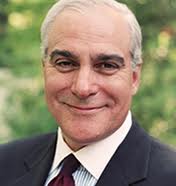 Career experience across the private, public and social ornonprofit sectors helps to develop significant leadership capacity.These “tri-sector leaders” develop sets of strengths that permitthem to engage and collaborate across sectors.
Career experience across the private, public and social ornonprofit sectors helps to develop significant leadership capacity.These “tri-sector leaders” develop sets of strengths that permitthem to engage and collaborate across sectors.
Harvard Business Review's recent article,“Triple-Strength Leadership” by Nick Lovegrove and Matthew Thomas,is based on interviews with more than 100 tri-sector leaders aroundthe world. These intersecting leadership credentials serve to meetthe multi-disciplinary challenges of society across sectors – frommanaging health care costs, to training the 21st centuryworkforce, to implementing new technologies and stabilizingfinancial systems to foster sustainable economic growth.
|In engaging with many of our clients, we recognize tri-sectorleadership in many senior executives who are pursuing amission-driven strategy for the benefit of their customers. Many have served in government and all work closely with governmentand regulators, often in shaping policy.
|Although credit unions are nonprofit entities, they are alsosuccessful, efficient businesses that serve important missions andsegments of the population. Forging intellectual threads fromdifferent sectors allows leaders to understand basic principlesfrom each and to transcend constraints that single-sector managersencounter when dealing with cross-sector issues. Breaking down asiloed mentality best serves members.
|There are challenges in developing tri-sector leaders, such asthe wide disparity of incomes among business, government andnonprofit organizations. There are perceived culturaldifferences. Many business executives view government and nonprofitorganizations as bureaucratic and ineffective. Some ingovernment may view business executives as focusing on monetaryself-interest and share price. The nonprofit world maybelieve they are the only ones focused on effectively building asustainable global future.
|Tri-sector leaders move beyond preconceptions and balancecompeting motives. The desire for personal wealth creation, usuallyassociated with the private sector, is balanced with a need forpositive and large-scale impact, usually associated withgovernment. There is a strong sense of mission – a primaryfocus of nonprofits. Tri-sector leaders in business focus oncreating shareholder value and appreciate the creation of publicvalue as well.
|Tri-sector leaders transfer skills learned in one sector andapply them in another, bringing innovation and creativity to servethe general good. Business executives may excel at allocatingresources to capture attractive market opportunities. Governmentofficials may bring competing interests together to create newlegal and policy frameworks. Nonprofit managers learncreative ways to focus their limited resources and often longertime horizons to accomplish their mission. Tri-sector leadersuse “contextual intelligence,” seeing parallels among sectors andaccurately assess their differences to provide effectivetranslation of skills and methods across sectors. This bolstersleadership and capacity thereby magnifying effectiveness.
|Tri-sector leaders use their extensive networks to build teamsand to convene diverse groups to address and resolve difficulttri-sector issues – repeatedly developing innovativesolutions.
|How do these tri-sector leaders develop? The career of atri-sector leadership is usually not planned. Thoseinterviewed said it happened organically, but it required a“prepared mind.” As Louis Pasteur said: “In the fields ofobservation, chance favors only the prepared mind.” From theoutset, these leaders think about the set of skills, capabilities,values, experiences and impact required to succeed in general andto be prepared for career opportunities as they arise, regardlessof the sector.
|Tri-sector leaders clearly are needed, but how can theirdevelopment be supported? Lovegrove and Thomas recommend a“lifecycle” approach, starting with an intellectual foundationthrough education at the start of a career, followed by practicalpathways to allow movement from sector to sector throughout acareer, without slowing forward momentum.
|Academic institutions can educate leaders for business andsociety, preparing graduates to act with integrity and a sense ofpurpose. These graduates should be equipped to excel infor-profit, nonprofit, government and entrepreneurial enterprises.Employers can attract, develop and retain exceptional tri-sectortalent.
|Indeed, some firms in consulting, law and even IT firms such asIBM have training programs that teach understanding of both cultureand values across sectors. Cross-sector experience can besystematically incorporated into the work environment by providingwork on assignments involving private, public and nonprofitcollaboration.
|The value of collaboration across government, business and civilsociety working together to deliver lasting sustainable solutionsis evident. Tri-sector leaders that are more idealistic, butpragmatic, rather than self-interested, can build bridges to helprealize this goal.
|The credit union industry serves as a role model, exhibitingthis triple strength leadership to benefit both society and theirmembers. The industry is well served by continuing to supportthe development of a new generation of tri-sector leadership.
|Stuart R. Levine is chairman/CEO of Stuart Levine &Associates. Contact (516) 465-0800or stuartlevine.com.
|Complete your profile to continue reading and get FREE access to CUTimes.com, part of your ALM digital membership.
Your access to unlimited CUTimes.com content isn’t changing.
Once you are an ALM digital member, you’ll receive:
- Critical CUTimes.com information including comprehensive product and service provider listings via the Marketplace Directory, CU Careers, resources from industry leaders, webcasts, and breaking news, analysis and more with our informative Newsletters.
- Exclusive discounts on ALM and CU Times events.
- Access to other award-winning ALM websites including Law.com and GlobeSt.com.
Already have an account? Sign In
© 2024 ALM Global, LLC, All Rights Reserved. Request academic re-use from www.copyright.com. All other uses, submit a request to [email protected]. For more information visit Asset & Logo Licensing.









